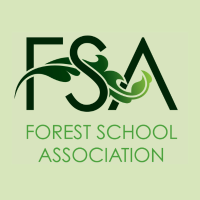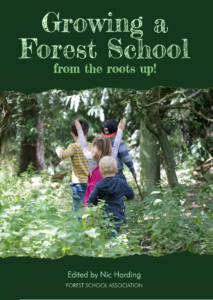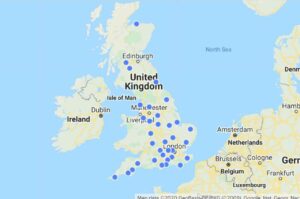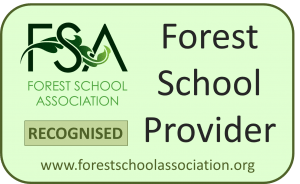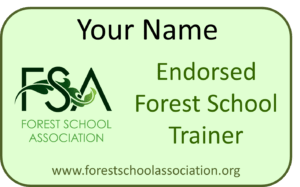‘Wellbeing in the Woods’ was the theme for this years FSA Conference. In Jon Cree’s ‘Wellbeing Workshop’, delegates explored ways of defining what wellbeing is but of equal importance, how to measure it:
‘Measuring what we are doing regarding well-being and social value was an aspect explored at two workshops. Other ways of measuring can include creative use of photos and reading the language of photos, indeed many Forest Schools use photos to communicate messages but when interpreted by both the practitioners and learners this can be such a powerful tool.’
John Cree article in ‘Words from the Woods‘ ![]()
In the same edition of Words we featured a letter from Emily Williams whose own research and measurements, including photographs, on how she has used her study of emotional development at FS to extend their FS provision are highlighted in this document letter ![]() and reproduced in full below.
and reproduced in full below.
The Ethos
Back in 2014, I was given the fantastic opportunity by our Head teacher, to train as a Level 3 Forest Schools Practitioner at Epping Forest and I have never looked back. It reinforced my strong belief that spending time immersed in nature with time to contemplate, experiment, question and share experiences can be vitally important to a person’s intellectual growth and emotional wellbeing. It seems to me, the natural course of a child’s development should always include regular time to explore their outdoor environment and time to wonder about what else they might discover….
So, after putting my knowledge into practice by delivering a Forest Schools Programme of Experiences to six children at a time: based around Guy Claxton’s BLP (Building Learning Power) themes of Resilience, Reciprocity, Reflectiveness and Resourcefulness- I think we may have cracked it! We seem to have found a way to integrate real Forest Schools practice without having to compromise on either staff to child ratio or the range and depth of challenge and experience on offer. This pleases me greatly.
We’ve faced problems, yes. Initially we had talked of taking our children off to neighbouring greenspaces such as our beautiful well-kept local community garden. Although this did work as a weekly class venture with the generous support of Natalie Ganpatsingh (Director of local community interest company Nature Nurture). It was financially unsustainable as a daily venture for our Forest School groups due to the need for additional staff to accompany children from to and from the site. That did not stop us though! We just rethought things. What if we could make our own grounds offer just as rich an outdoor experience? We set to work. Collaborating with The Conservation Volunteers, we won funding to enrich our school front garden. They rebuilt our raised beds and improved our pond area. They wove willow plant supports and helped to begin the creation of a giant mud head sculpture inspired by my recent visit the Lost Gardens of Heligans.
Since then my Forest School groups have taken ownership of their outdoor areas and have dreamt up their own projects to develop our outdoor space. We created a mini- nature reserve in our front garden bordered by the busy (and pretty noisy!) Oxford Road. It has changed over the year. The more we have planted the more peaceful it has become. We now spend ‘moments of special silence’ out there and actually hear birdsong, notice hoverflies, watch the butterflies and ants go about their business. We’ve had dragonflies emerge from our pond. It’s a fascinating place to be. Have you heard about the old dragon who sleeps in our boiler room? When he’s awake he uses his fiery breath to heat up the hot water for our school- sometimes his breath catches in our withy shelter, and it cools to become a beautiful rainbow thread! If you twist two pieces together really tight then magic happens and it weaves into a colourful friendship bracelet. We wear ours all the time as if you do then you are more likely to see the little people (Fairies) that share our garden.
Campfires around our fire circle are I think I’m safe to say, the most exciting and mesmerizing experience so far…. At Forest School we learn to take great care using tools and how to keep ourselves and each other safe around the fire and as we explore all areas outside. Our Kitchen Garden was really productive at Harvest time. We made and sold chutney and reinvested the profits. We grew Woad and managed to extract blue pigment just like the Celts years ago! We made Chamomile tea, Elderflower Cordial, Mint sauce and cooked Salmon on the fire. The list goes on. Sometime Sybil the dog comes to visit and we’ve been learning how to read her body language, as she can’t speak like us. It’s not hard to train her though as she’s clever and likes to work for a reward. We’re getting pretty good at looking after animals. Our family of African Land Snails live in the Reception Class room and Nursery have a tank full of Indian Stick insects! We have an outdoor disco in our playground, an extremely popular Mud Kitchen, a nature inspired Mural, and now a Wildflower Meadow and relaxation area surrounded by hedgerow (we planted it during ‘Green Gym’ as part of Sports Relief). We are growing a lawn where we will walk barefoot within our meadow area our lie down on the grass if we want to. It’s a lot more comfy than tarmac.
Proving It!
As an educational team, we have witnessed the way that these opportunities for children to build and strengthen relationships between themselves and the natural environment have influenced their attitude and behaviours. It has been especially noticeable in those with particular emotional and social need. And in those that are naturally drawn to sensual experiences and imaginative play. As we noticed a pattern we drew similarities and saw that many of the benefits of Forest School small group experiences were in line with the ELSA (Emotional Literacy Support Assistant) programme that some members of staff were also delivering here at Oxford Road Community School. It was decided between us that we would try to capture this progressive trend using the same ‘Granada Learning- Emotional Literacy assessment’ method.
“Emotional Literacy concerns the ability of people to recognize, understand, handle and appropriately express their own emotions, and to recognize, understand and respond appropriately to the expressed emotions of others. Thus enabling positive relationships, emotional strength and positive empowerment.” Granada Learning- GL Assessment ltd ISBN: 0708716288
The questionnaires are designed to capture a score for each of these categories: self-awareness, self-regulation, motivation, empathy, and social skills. The sum of these elements has a top score of 100%. So for example, data collected from both the teacher review and pupil review might give an ELSA score such as Pupil Score= 48% Teacher Score = 51%. Each of these percentage scores can be broken down and plotted on a graph as a subscale so that the skills that need building on most can be clearly identified. The Forest School leader will then take these individual ELSA profiles into account when working with a group. This information can be helpful to monitor a pupil’s long-term personal development.
The results from each child’s data reflected what we had seen and believed. All our Forest School children had grown in their self-awareness, self-regulation, motivation, social skills and empathy. The best example of this was a child from year 6. Their data was as follows:
21/09/15 Pupil questionnaire score = 41% Teacher questionnaire score = 51.25
30/11/15 Pupil questionnaire score = 88% Teacher questionnaire score = 71.25
It seems to me clear that this approach is having a deep and lasting impact on our children’s wellbeing and ability to face challenges calmly, confidently and in a creative way. Just as we had intended. Success!
By changing our group of six Forest School children in each year group every half term, we have been able to offer an annual 5-10 week programme of 2hr sessions, to each and every child from year 1 all the way up to year 6. When the group come to the final session- they are presented with a certificate which reads “You know how to Forest School! Now show your family and friends.” They also get a special Forest Schools Handbook, which tells them all they need to know to set up their own Forest School outside of our school grounds. It include the rules to keep us safe and a couple of maps of local nature reserves to get them started.
Our Findings
| Pupil Review % | Teacher Review% | Pupil and Teacher Average % | ||
| 5-6 Sessions | Max | 17.00 | 28.75 | 22.88 |
| Average | 4.90 | 8.83 | 6.87 | |
| 10 Sessions | Max | 47.00 | 28.75 | 37.88 |
| Average | 6.21 | 10.10 | 8.16 | |
| All Sessions (5,6,10) | Max | 47.00 | 28.75 | 37.88 |
| Average | 5.62 | 9.19 | 7.40 | |
| Two Courses | Max | 30 | 48.75 | 39.38 |
| Average | 12.38462 | 15.67308 | 14.03 |
The columns in the chart above show the difference between the scores taken from the GL- ELSA questionnaires at the start and finish of our Earthling’s Forest School courses.
We have noticed that a longer course of regular Forest School sessions is of greater benefit. Even if there is a significant time between courses; for example if they take place annually.
In order for our Forest School programme to be offered to all our Primary aged children at Oxford Road Community School, we usually limit course length to between 5-10wks to allow each child a chance to participate in a small group ( 6 children) session each academic year.
As a result of these findings, we now offer six targeted children with particular need a long-term programme, reviewed every half-term.

During the interim period between FS courses, pupils lost on average 1.46% on the ELSA score. As these pupils gained around 10.6% from their first FS course, 86% of skills gained were retained on average.
Upon completing the first course of FS, pupils improved their ELSA score by around 10.6%. By the end of their second course pupils increased again by around 5.22%.
After completing two separate courses of 5-10 sessions, pupils improved their ELSA score by around 14% despite a usual year interval between courses. However, it was shown that 5 out of 13 pupils achieved increases of 20% or more. One of these pupils made a massive increase of over 38%.
Some of the children who did not make as significant gains had experienced a change of classroom teacher in the academic year and this may have contributed to a lower score change. If this was to be avoided in the future, a higher average increase is likely to be found.
It is expected that the % difference between the ELSA questionnaire before and after scores would inevitably decrease over the years. This is because we anticipate that most pupils will continue to build their learning power on the skills retained from previous FS sessions.
Building Learning Power – The Data (Excel)
Conclusion
This data was collected between Sept 2015-16. Since then we have continued to monitor the impact of our Forest School sessions using the same method. We may be able to share this information if it can be of help to others. Please contact Emily with any queries.
Email: emily.williams@oxfordroad.reading.sch.uk Tel no. 07896 891545
By Emily Williams | Outdoor Learning Co-ordinator at Oxford Road Community School, Reading, Berks | 28/06/2017
